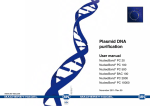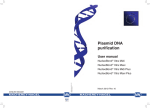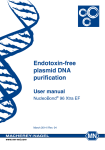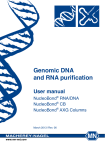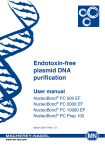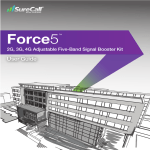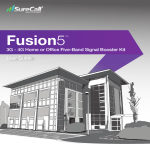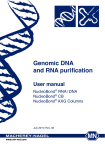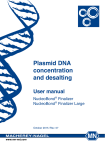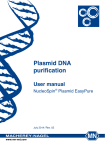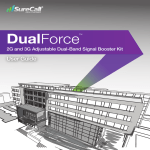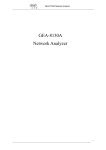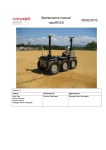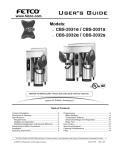Download Plasmid DNA Purification
Transcript
Plasmid DNA Purification User manual NucleoBond® PC 20 NucleoBond® PC 100 NucleoBond® PC 500 NucleoBond® BAC 100 NucleoBond® PC 2000 NucleoBond® PC 10000 March 2005/Rev. 03 www.mn-net.com MACHEREY-NAGEL MN MACHEREY-NAGEL DIN EN ISO 9001: 2000 CERTIFIED MACHEREY-NAGEL MACHEREY-NAGEL MACHEREY-NAGEL MN Protocol at a glance (Rev. 03) Plasmid DNA Purification (Mini, Midi, Maxi, Mega, Giga) step 1 Cultivate and harvest bacterial cells 2 Cell lysis Maxi Mega Giga (AX 20) (AX 100) (AX 500) (AX 2000) (AX 10000) 4,500-6,000 x g 15 min at 4°C 4,500-6,000 x g 15 min at 4°C 4,500-6,000 x g 15 min at 4°C 4,500-6,000 x g 15 min at 4°C 4,500-6,000 x g 15 min at 4°C high copy / low copy 0.4 ml / 0.8 ml 4 ml / 8 ml 12 ml / 24 ml 45 ml / 90 ml 120 ml / - Buffer S2 0.4 ml / 0.8 ml 4 ml / 8 ml 12 ml / 24 ml 45 ml / 90 ml 120 ml / - Buffer S3 0.4 ml / 0.8 ml 4 ml / 8 ml 12 ml / 24 ml 45 ml / 90 ml 120 ml / - Buffer N2 1 ml Buffer N2 2.5 ml Buffer N2 6.0 ml Buffer N2 20 ml Buffer N2 100 ml Centrifugation Folded filter or centrifugation Folded filter or centrifugation Folded filter or centrifugation Folded filter or centrifugation 15 min 12,000 x g 25 min 12,000 x g 40 min 12,000 x g 50 min 12,000 x g 60 min 12,000 x g Load cleared lysate onto the column Load cleared lysate onto the column Load cleared lysate onto the column Load cleared lysate onto the column Load cleared lysate onto the column Buffer N3 Buffer N3 Buffer N3 Buffer N3 Buffer N3 high copy 2 x 1.5 ml high copy 10 ml high copy 32 ml high copy 2 x 35 ml high copy 2 x 100 ml low copy 2 x 2 ml low copy 12 ml low copy 2 x 18 ml low copy 2 x 50 ml Buffer N5 1 ml Buffer N5 5 ml Buffer N5 15 ml Buffer N5 25 ml Buffer N5 100 ml Isopropanol 0.75 ml Isopropanol 3.5 ml Isopropanol 11 ml Isopropanol 18 ml Isopropanol 70 ml 15,000 x g 30 min at 4°C 15,000 x g 30 min at 4°C 15,000 x g 30 min at 4°C 15,000 x g 30 min at 4°C 15,000 x g 30 min at 4°C 70% ethanol 500 µl 70% ethanol 2 ml 70% ethanol 5 ml 70% ethanol 7 ml 70% ethanol 10 ml 15,000 x g 10 min at RT 15,000 x g 10 min at RT 15,000 x g 10 min at RT 15,000 x g 10 min at RT 15,000 x g 10 min at RT 5-10 min 5-10 min 10-20 min 30-60 min 30-60 min Appropriate volume of TE Appropriate volume of TE Appropriate volume of TE Appropriate volume of TE Appropriate volume of TE Equilibration of the column 4 Clarification of the lysate 5 Binding 6 Washing 7 Elution 8 Precipitation 10 Midi Buffer S1 3 9 Mini Wash and dry DNA pellet Reconstitute DNA Plasmid DNA Purification Table of contents 1 Kit contents 4 2 Introduction 9 2.1 Properties 9 2.2 About this user manual 3 Product description 10 11 3.1 The basic principle 11 3.2 Kit specifications 11 3.3 Buffer compositions 12 3.4 High-/low-copy plasmid purification 13 3.5 Filtration of the lysate 14 3.6 Elution procedures 15 4 Storage conditions and preparation of working solutions 16 5 Safety instructions - risk and safety phrases 17 6 Growing of bacterial cultures 18 6.1 General considerations 18 6.2 Selection of culture media 19 6.3 Difficult-to-lyse strains 19 7 NucleoBond® plasmid purification 20 7.1 General procedure 20 7.2 High-copy plasmid purification (Mini-Midi-Maxi) 20 7.3 High-copy plasmid purification (Mega-Giga) 23 7.4 Low-copy plasmid purification (Mini-Midi) 26 7.5 Low-copy plasmid purification (Maxi/BAC-Mega) 29 8 Appendix 32 8.1 Determination of DNA yield and quality 32 8.2 Troubleshooting 32 8.3 Ordering information 38 8.4 References 39 8.5 Product use restriction / warranty 39 MACHEREY-NAGEL – 03/2005/ Rev. 03 3 Plasmid DNA Purification 1 Kit contents NucleoBond® PC 20 20 preps 100 preps Cat. No. 740571 740571.100 Buffer S1 20 ml 2 x 35 ml Buffer S2 20 ml 2 x 35 ml Buffer S3 20 ml 2 x 35 ml Buffer N2 25 ml 125 ml Buffer N3 2 x 35 ml 3 x 125 ml Buffer N5 35 ml 125 ml RNase A (lyophilized) 2 mg 2 x 4 mg 20 100 - - Plastic washer 10 10 Protocol 1 1 NucleoBond® AX 20 columns NucleoBond® folded filters For preparation of working solutions and storage conditions see section 4. 4 MACHEREY-NAGEL – 03/2005/ Rev. 03 Plasmid DNA Purification 1 Kit contents continued NucleoBond® PC 100 20 preps 100 preps Cat. No. 740573 740573.100 Buffer S1 120 ml 2 x 250 ml Buffer S2 120 ml 2 x 250 ml Buffer S3 120 ml 2 x 250 ml Buffer N2 70 ml 2 x 150 ml Buffer N3 240 ml 3 x 400 ml Buffer N5 120 ml 3 x 200 ml RNase A (lyophilized) 12 mg 2 x 25 mg NucleoBond® AX 100 columns 20 100 NucleoBond® folded filters 20 100 Plastic washer 10 10 Protocol 1 1 For preparation of working solutions and storage conditions see section 4. MACHEREY-NAGEL – 03/2005/ Rev. 03 5 Plasmid DNA Purification 1 Kit contents continued NucleoBond® PC 500 10 preps 25 preps 50 preps 100 preps Cat. No. 740574 740574.25 740574.50 740574.100 Buffer S1 150 ml 2 x 200 ml 2 x 400 ml 3 x 500 ml Buffer S2 150 ml 400 ml 2 x 400 ml 3 x 500 ml Buffer S3 150 ml 400 ml 2 x 400 ml 3 x 500 ml Buffer N2 70 ml 200 ml 2 x 200 ml 4 x 200 ml Buffer N3 2 x 250 ml 2 x 500 ml 2 x 1000 ml 3 x 1000 ml 500 ml Buffer N5 200 ml 500 ml 2 x 500 ml 3 x 500 ml 200 ml RNase A (lyophilized) 15 mg 2 x 25 mg 2 x 40 mg 3 x 50 mg NucleoBond® AX 500 columns 10 25 50 100 NucleoBond® folded filters 10 25 50 100 Plastic washer 5 10 10 10 Protocol 1 1 1 1 For preparation of working solutions and storage conditions see section 4. 6 MACHEREY-NAGEL – 03/2005/ Rev. 03 Plasmid DNA Purification 1 Kit contents continued NucleoBond® PC 2000 NucleoBond® PC 10000 5 preps 5 preps Cat. No. 740576 740593 Buffer S1 250 ml 750 ml Buffer S2 250 ml 750 ml Buffer S3 250 ml 750 ml Buffer N2 140 ml 500 ml 120 ml Buffer N3 2 x 250 ml 1000 ml 2 x 200 ml Buffer N5 200 ml 500 ml 120 ml RNase A (lyophilized) 25 mg 80 mg NucleoBond® AX 2000 columns 5 - NucleoBond® AX 10000 columns - 5 NucleoBond® folded filters 5 10 Plastic washer 5 - Protocol 1 1 For preparation of working solutions and storage conditions see section 4. MACHEREY-NAGEL – 03/2005/ Rev. 03 7 Plasmid DNA Purification 1 Kit contents continued NucleoBond® BAC 100 10 preps Cat. No. 740579 Buffer S1 2 x 150 ml Buffer S2 2 x 150 ml Buffer S3 2 x 150 ml Buffer N2 70 ml Buffer N3 2 x 200 ml Buffer N5 150 ml RNase A (lyophilized) 2 x 15 mg NucleoBond® BAC 100 columns 10 NucleoBond® folded filters 10 Plastic washer 5 Protocol 1 For preparation of working solutions and storage conditions see section 4. 8 MACHEREY-NAGEL – 03/2005/ Rev. 03 Plasmid DNA Purification 2 Introduction 2.1 Properties NucleoBond® AX is a silica-based anion-exchange resin, developed by MACHEREY-NAGEL, for routine separation of different classes of nucleic acids. NucleoBond® AX resin, covered under European Patent EP 0496822, forms the basis for the entire line of nucleic acid purification products presented in this User Manual. NucleoBond® AX resin consists of hydrophilic, macro porous silica beads coupled to a methyl-ethylamine functional group. The functional group provides a high overall charge density that permits the negatively charged phosphate backbone of plasmid DNA to bind with high specificity to the resin. Due to a specialized manufacturing process that is rigorously controlled and monitored, the beads are uniform in diameter and contain particularly large pores. These special properties allow for optimum flow rates through the column and more efficient binding of nucleic acids to the matrix. Thus, using the matrix you can achieve sharp, well-defined elution profiles for individual nucleic acid species (see Figure 1). NucleoBond® AX can separate distinct nucleic acids from each other and from proteins, carbohydrates, and other unwanted cellular components. The purified nucleic acid products are suitable for use in the most demanding molecular biology applications, including transfection, in vitro transcription, automated or manual sequencing, cloning, hybridization, and PCR. Compound class: Plasmid DNA, DNA Double-stranded DNA (150 bp) Single-stranded DNA (M 13) mRNA 16S/23S rRNA 5S RNA 0.5 M Bovine serum albumin buffer N3 buffer N2 tRNA 1M trinucleotides Proteins, dyes, polysaccharides, metabolites 1.5 M Salt concentration for elution Figure 1. Elution profiles for distinct nucleic acid species using NucleoBond® AX columns. Nucleic acids can be eluted over a range of 0.5 M KCl to 1.5 M KCl; profiles for each nucleic acid are sharp and virtually non-overlapping. MACHEREY-NAGEL – 03/2005/ Rev. 03 9 Plasmid DNA Purification 2.2 About this user manual Experienced users who are performing the purification of high-copy plasmids using a NucleoBond® Plasmid purification kit may refer to the Protocol-at-a-glance instead of this user manual. The Protocol-at-a-glance is designed to be used only as a supplemental tool for quick referencing while performing the purification procedure. Firsttime users are strongly advised to read this user manual. The protocols in this manual are organized as follows: The volumes of the respective buffers used for a particular column size are highlighted. Each procedural step is arranged like the following example (taken from section 7.2 High-copy plasmid purification): 1 Mini Midi Maxi (AX 20) (AX 100) (AX 500) Carefully resuspend the pellet of bacterial cells in buffer S1 + RNase A. Please see section 6.3 regarding difficult-to-lyse strains. 0.4 ml 4 ml 12 ml For example, if you are performing a Mini Prep to purify plasmid DNA using an AX 20 column you are requested to refer to the white boxes. In these boxes there are noted the volumes of buffers to be used. The name of the buffer, the indicated volume is referring to, is highlighted in bold type within the instruction. Referring to the a.m. example the pellet of the bacterial cells has to be resuspended in 0.4 ml of buffer S1 when performing a Mini prep using NucleoBond® AX 20 columns. 10 MACHEREY-NAGEL – 03/2005/ Rev. 03 Plasmid DNA Purification 3 Product description 3.1 The basic principle NucleoBond® PC/BAC Kits employ a modified alkaline/SDS lysis procedure to prepare the bacterial cell pellet for plasmid purification. Both chromosomal and plasmid DNA are denatured under these alkaline conditions. Potassium acetate is then added to the denatured lysate, which causes the formation of a precipitate containing chromosomal DNA and other cellular compounds. The potassium acetate buffer also neutralizes the lysate. Plasmid DNA, which remains in solution, can revert to its native supercoiled structure. After equilibrating the appropriate NucleoBond® column with equilibration buffer, plasmid DNA is bound to the anion-exchange resin and finally eluted after efficient washing of the column. After precipitation of the eluted DNA it can easily be dissolved in TE buffer for further use. 3.2 Kit specifications • NucleoBond® Plasmid Purification Kits contain NucleoBond® columns, appropriate buffers, and RNase A. Kits are available for each column size: Mini (PC 20), Midi (PC 100), Maxi (PC 500, BAC 100), Mega (PC 2000), and Giga (PC 10,000). • The protocols are suitable for purifying most plasmids ranging from 3->10 kb, cosmids from 10–50 kb, and very large constructs (P1 constructs, BACs, PACs) up to 300 kb. • NucleoBond® columns are polypropylene columns containing NucleoBond® AX silica resin packed between two inert filter elements. NucleoBond® columns are used to purify plasmids, cosmids, P1 constructs, BACs, PACs, and phage DNA (not described in this user manual). The columns are available in several sizes to accommodate a wide range of purification needs (see Table 1). Table 1: NucleoBond® column binding capacities NucleoBond® column Binding capacity AX 20 20 µg AX 100 100 µg AX 500 500 µg BAC 100 500 µg AX 2000 2 mg AX 10000 10 mg MACHEREY-NAGEL – 03/2005/ Rev. 03 11 Plasmid DNA Purification • All NucleoBond® columns are resistant to organic solvents such as alcohol, chloroform, and phenol and are free of DNase and RNase. • NucleoBond® AX resin can be used over a wide pH range, from pH 2.5–8.5, and can remain in contact with buffers for up to three hours without any change in its chromatographic properties. After three hours, nucleic acids will begin to elute at increasingly lower salt concentrations. Normally, the resin remains functional in buffers containing up to 2 M salt. It remains intact in the presence of denaturing agents like formamide, urea, or common detergents such as Triton X-100 and NP-40. 3.3 Buffer compositions Buffer S1: • 50 mM Tris-HCl, 10 mM EDTA, 100 µg/ml RNase A, pH 8.0 Buffer S2: • 200 mM NaOH, 1% SDS Buffer S3: • 2.8 M KAc, pH 5.1 Buffer N2: • 100 mM Tris, 15% ethanol, 900 mM KCl, 0.15% Triton X-100, adjusted to pH 6.3 with H3PO4 Buffer N3: • 100 mM Tris, 15% ethanol, 1.15 M KCl, adjusted to pH 6.3 with H3PO4 Buffer N5: • 100 mM Tris, 15% ethanol, 1 M KCl, adjusted to pH 8.5 with H3PO4 Note: Keep all buffers tightly capped. The concentration of KCl required for eluting the desired nucleic acid is highly dependent on the pH value of the eluent. For this reason, pH values must be carefully controlled if the buffers have been prepared by the customer. A deviation of more than 0.1 pH unit from the given values may affect yields. If you are consistently experiencing reduced product yields, check the pH of all buffers before continuing. Buffers should be adjusted with H3PO4 or KOH. 12 MACHEREY-NAGEL – 03/2005/ Rev. 03 Plasmid DNA Purification 3.4 High-/low-copy plasmid purification NucleoBond® PC kits are recommended for the isolation of high-copy plasmids (>20 copies/cell), however, low-copy plasmids (<20 copies/cell) can be isolated as well. If you are purifying low-copy plasmids, you will need to supplement the NucleoBond® PC kits with additional buffers. We recommend the NucleoBond® Buffer Set I (Cat. No. 740601) for routine purification of low-copy plasmids. The NucleoBond® Buffer Set I can be used in connection with NucleoBond® P C kits for the isolation of low-copy plasmids. In this combination it is sufficient for • NucleoBond® PC 500 kit (Cat. No. 740574), 10 preparations low-copy plasmid purification • NucleoBond® PC 100 kit (Cat. No. 740573), 20 preparations low-copy plasmid purification • NucleoBond® PC 20 kit (Cat. No. 740571.100), 100 preparations low-copy plasmid purification. In connection with NucleoBond® AX columns the NucleoBond® Buffer Set I can be used for the isolation of high-copy plasmids. In this combination it is sufficient for • NucleoBond® AX 500 columns (Cat. No. 740531) 5 preparations high-copy plasmid purification • NucleoBond® AX 100 columns (Cat. No. 740521) 10 preparations high-copy plasmid purification • NucleoBond® AX 20 columns (Cat. No. 740511) 50 preparations high-copy plasmid purification. The NucleoBond® BAC 100 kit is recommended for the isolation of low-copy plasmids and contains sufficient buffer to perform 10 maxi preps. The kit contains BAC 100 columns, which can bind up to 500 µg of plasmid DNA. Typically yields are 10100 µg from 500 ml fermentation broth depending on copy number and size of constructs (also see section 6 for further information regarding the growing of bacterial cultures). The protocol for the isolation of low-copy plasmids using the NucleoBond® BAC 100 kit can be found in section 7.5. MACHEREY-NAGEL – 03/2005/ Rev. 03 13 Plasmid DNA Purification 3.5 Filtration of the lysate After alkaline lysis, the solution has to be clarified from e.g. the cell debris through the supplied NucleoBond® folded filters or NucleoBond® bottle top filters in order to prevent clogging of the column. • Use the provided NucleoBond® folded filters for filtration of the lysate (Figure 2). Folded filters are designed to eliminate the centrifugation step after alkaline lysis for plasmid isolation. The filters completely remove SDS and cellular debris from plasmid samples. Furthermore, Folded Filters avoid shearing of large DNA constructs, such as PACs or BACs. Folded Filters should not be used with AX 20 (Mini) columns for plasmid preparation due to the small culture volumes which allow an easy and quick clearing of the lysate in a microcentrifuge. Due to the large culture volume two folded fiters (Type 1 and Type 2) are included in the NucleoBond® PC 10000 kit in order to guarantee an optimal removal of SDS and cellular debris from plasmid sample. For correct use please follow the instructions given in step 4 of the corresponding protocol. Figure 2: Correct use of the folded filters • Alternatively: Centrifuge the solution with the given acceleration forces and times as written in step 4 of the corresponding protocols. Load the cleared lysate onto the column. • For the AX 2000 (Mega) column and AX 10000 (Giga) column also the vacuum operated NucleoBond® bottle top filters can be used for filtration of the lysate. The NucleoBond® bottle top filters (Figure 3) make the separation of the bacterial lysate and SDS precipitate easily, quickly, and conveniently. When using a NucleoBond® bottle top filter it is not necessary to centrifuge the solution first, as described in step 4, option 1 and 2 of the corresponding protocol. Adjust the bottle top filter to a suitable flask (e.g. Schott), load the bacterial lysate and apply the vacuum. After 3-5 min the solution will have passed through. Load the resulting clear lysate onto the corresponding NucleoBond® AX column and discard the bottle top filter. Figure 3: Correct use of the NucleoBond® bottle top filter 14 MACHEREY-NAGEL – 03/2005/ Rev. 03 Plasmid DNA Purification 3.6 Elution procedures Elution is carried out into a new tube with the volume of elution buffer indicated in the corresponding protocol. The plasmid DNA is precipitated by the addition of roomtemperature (20-25°C) isopropanol. Do not let the plasmid DNA solution drop into a vial with isopropanol, because this leads to spontaneous co-precipitation of salt. Only use room-temperature (20-25°C) isopropanol to prevent spontaneous coprecipitation of salt. MACHEREY-NAGEL – 03/2005/ Rev. 03 15 Plasmid DNA Purification 4 Storage conditions and preparation of working solutions Attention: Buffer S2 contains sodium dodecylsulfate and sodium hydroxide. Wear gloves and goggles! • All kit components can be stored at room temperature (20-25°C) and are stable up to two years. Before you start any NucleoBond® Plasmid DNA purification prepare the following: 16 • Dissolve the lyophilized RNase A by the addition of 1 ml of buffer S1. Wearing gloves is recommended. Pipette up and down until the RNase A is dissolved completely. Transfer the RNase A solution back to the bottle containing buffer S1 and shake well. Indicate date of RNase A addition. The final concentration of RNase A is 100 µg/ml buffer S1. Store buffer S1 with RNase A at 4°C. The solution will be stable at this temperature up to 6 months. • Buffer S2 should be stored at room-temperature (20-25°C) since the containing SDS may precipitate at temperatures below 20°C. If precipitation occurs, incubate the bottle for several minutes at about 30-40°C and mix well until the precipitate is redissolved. MACHEREY-NAGEL – 03/2005/ Rev. 03 Plasmid DNA Purification 5 Safety instructions - risk and safety phrases The following components of the NucleoBond® PC kits contain hazardous contents. Wear gloves and goggles and follow the safety instructions given in this section. Component Hazard Contents Hazard Symbol Risk Safety Phrases Phrases RNase A RNase A, lyophilized Xn May cause sensitization by inhalation R 42/43 and skin contact S 7-16-22 S2 sodium hydroxide <2% Xi Irritating to eyes and skin S 22-2426-36/37 R 36/38 Risk Phrases R 36/38 Irritating to eyes and skin R 42/43 May cause sensitization by inhalation and skin contact Safety Phrases S7 Keep container tightly closed S 16 Keep away from sources of ignition - No Smoking! S 22 Do not breathe dust S 24 Avoid contact with the skin S 26 In case of contact with eyes, rinse immediately with plenty of water and seek medical advice S 36/37 Wear suitable protective clothing and gloves Label not necessary, if quantity below 125 g or ml (concerning 67/548/EEC Art. 25, 1999/45/EC Art. 12 and German GefStoffV § 42 and TRGS 200 7.1) Label not necessary, if quantity below 25 g or ml (concerning 67/548/EEC Art. 25, 1999/45/EC Art. 12 and German GefStoffV § 42 and TRGS 200 7.1) MACHEREY-NAGEL – 03/2005/ Rev. 03 17 Plasmid DNA Purification 6 Growing of bacterial cultures 6.1 General considerations Yield and quality of plasmid DNA depends on e.g. the type of growing media and antibiotics, the bacterial host, plasmid type, size, or copy number. Therefore, these factors should be taken into consideration. For cultivation of bacterial cells, we recommend LB medium. The suggested bacterial culture volumes for each column size as well as expected plasmid yields are listed in Table 2. Overnight cultures in flasks usually reach, under vigorous shaking, an OD600 of 3-6, while fermentation cultures reach 10 and more. Therefore, please refer not only to the culture volume, but also check OD600 and pellet wet weight, too in particular if richer culture media like 2xYT or TB are used. If too much bacterial material is used, lysis and precipitation steps are inefficient and finally NucleoBond® columns are overloaded causing decreased yield and plasmid quality. As a general rule, 1 liter E.coli culture grown in LB medium yields a pellet of about 3-20 g wet weight. The expected yield for a high-copy-number plasmid is 1-3 mg per gram wet weight. Table 2: Recommended culture volume Copy plasmids High copy Low copy LB culture volume Wet weight Recommended of pellet column size Average yield 1-5 ml - AX 20 (Mini) 3-20 µg 5-30 ml - AX 100 (Midi) 20-100 µg 30-150 ml 0.75 g AX 500 (Maxi) 100-500 µg 150-500 ml 2.5 g AX 2000 (Mega) 500 µg-2 mg 500-2,000 ml 10 g AX 10000 (Giga) 2 mg-10 mg 3-10 ml - AX 20 (Mini) 1-100 ml - AX 100 (Midi) 20-100 µg 100-500 ml 1.5-2.2 g AX 500 (Maxi) 100-500 µg 100-500 ml 1.5-2.2 g BAC 100 (Maxi) 100 µg 5-7.5 g AX 2000 (Mega) 500 µg-2 mg 500-2,000 ml 3-20 µg For AX 20 and AX 100 it is not necessary to measure the wet weight but depending on the media used, OD600 should be determined. For a low copy protocol using AX 10000 (Giga) columns please call our Technical Service Center. 18 MACHEREY-NAGEL – 03/2005/ Rev. 03 Plasmid DNA Purification 6.2 Selection of culture media The cultivation of cells is recommended at 37°C in LB (Luria-Bertani) medium at constant shaking (200-250 rpm). Alternatively, rich media like 2xYT (Yeast/Tryptone) or TB (Terrific Broth) can be used. By using 2xYT or TB, bacteria grow faster and reach the stationary phase much earlier than in LB medium ( 12 h). This may lead to a higher percentage of dead or starving cells when starting the preparation. The resulting plasmid DNA from overgrown cultures may be partially degraded or contaminated with chromosomal DNA. For Mini and Midi preps cultivation in flasks is recommended. At least for Mega and Giga preps the use of an appropriate fermentation system is recommended in order to optimize cultivation conditions. 6.3 Difficult-to-lyse strains Isolate plasmid DNA from difficult-to-lyse strains by first resuspending the pellet in buffer S1 containing lysozyme (2 mg/ml final concentration). Incubate at 37°C for 30 minutes, then continue with the addition of buffer S2, and proceed with the appropriate NucleoBond® protocol. MACHEREY-NAGEL – 03/2005/ Rev. 03 19 Plasmid DNA Purification NucleoBond® plasmid purification 7 7.1 General procedure Prepare an overnight culture: • Set up an overnight bacterial culture by inoculating the appropriate volume of LB medium (plus antibiotic) with a single colony picked from a freshly streaked plate. Shake the culture overnight (12–16 h) with selecting antibiotics added to the medium. • Centrifuge the culture at 6,000 x g for 15 min at 4°C. Carefully discard the supernatant. 7.2 High-copy plasmid purification (Mini-Midi-Maxi) 1 Mini Midi Maxi (AX 20) (AX 100) (AX 500) Cultivate and harvest bacterial cells Harvest bacteria from an LB culture by centrifugation at 4,500 - 6,000 x g for 15 min at 4°C. 2 Cell lysis Carefully resuspend the pellet of bacterial cells in buffer S1 + RNase A. Please see section 6.3 regarding difficult-to-lyse strains. 0.4 ml 4 ml 12 ml Add buffer S2 to the suspension. Mix gently by inverting the tube 6-8 times. Incubate the mixture at room temperature (20-25°C) for 2–3 min (max 5 min). Do not vortex, as this will release contaminating chromosomal DNA from the cellular debris into the suspension. 0.4 ml 4 ml 12 ml Add pre-cooled buffer S3 (4°C) to the suspension. Immediately mix the lysate gently by inverting the flask 6-8 times until a homogeneous suspension containing an off-white flocculate is formed. Incubate the suspension on ice for 5 min. 0.4 ml 20 4 ml MACHEREY-NAGEL – 03/2005/ Rev. 03 12 ml Plasmid DNA Purification 3 Mini Midi Maxi (AX 20) (AX 100) (AX 500) Equilibration of the column Equilibrate a NucleoBond® AX 20 (Mini), AX 100 (Midi) or AX 500 (Maxi) column with buffer N2. Allow the column to empty by gravity flow. Discard flow-through. 1.0 ml 4 2.5 ml 6.0 ml Clarification of the lysate Clear the bacterial lysate by following EITHER option 1 (Midi, Maxi) or option 2 (Mini, Midi, Maxi), described below. This step is extremely important; excess precipitate left in suspension may clog the NucleoBond® column in later steps. Option 1. Filter the suspension. Place a NucleoBond® folded filter in a small funnel for support, and prewet the filter with a few drops of buffer N2 or sterile deionized H2O. Load the bacterial lysate onto the wet filter and collect the flow-through. Note: Do not use NucleoBond® folded filters with AX 20 columns (Mini preps). Alternatively: Option 2. Centrifuge the suspension. Centrifuge at >12,000 x g for the minimum time indicated below at 4°C. If the suspension contains residual precipitate after the first centrifugation, either repeat this step or proceed with option 1. 15 min 5 25 min 40 min Binding Load the cleared lysate from step 4 onto the NucleoBond® column. Allow the column to empty by gravity flow. Optional: You may want to save all or part of the flow-through for analysis. 6 Washing Wash the column with buffer N3. Repeat as indicated. Discard flow-through. 2 x 1.5 ml 10 ml MACHEREY-NAGEL – 03/2005/ Rev. 03 32 ml 21 Plasmid DNA Purification 7 Mini Midi Maxi (AX 20) (AX 100) (AX 500) Elution Elute the plasmid DNA with buffer N5. We recommend precipitating the eluate as soon as possible (step 8). Nevertheless, the eluate can be stored in closed vials on ice for some hours. In this case the eluate should be prewarmed to room temperature before the plasmid DNA is precipitated. 1 ml 5 ml 15 ml Optional: Determine plasmid yield by UV spectrophotometry in order to adjust the desired concentration of DNA (step 10). 8 Precipitation Add room-temperature isopropanol to precipitate the eluted plasmid DNA. Mix carefully and centrifuge at 15,000 x g for 30 min at 4°C. Carefully discard the supernatant. 0.75 ml 9 3.5 ml 11.0 ml Wash and dry DNA pellet Add room-temperature 70% ethanol to the pellet. Vortex briefly and centrifuge at 15,000 x g for 10 min at room temperature (20-25°C). 500 µl 2 ml 5 ml Carefully remove ethanol from the tube with a pipette tip. Allow the pellet to dry at room temperature (20-25°C), no less than the indicated time. Drying for longer periods will not harm the quality of the plasmid DNA. 5-10 min 5-10 min 10-20 min 10 Reconstitute DNA Redissolve the DNA pellet in an appropriate volume of buffer TE or sterile deionized H2O. Depending on the type of centrifugation-tube, redissolve under constant spinning in a sufficient amount of buffer for 10-60 min (3D-shaker). Determine plasmid yield by UV spectrophotometry. Confirm plasmid integrity by agarose gel electrophoresis. 22 MACHEREY-NAGEL – 03/2005/ Rev. 03 Plasmid DNA Purification 7.3 High-copy plasmid purification (Mega-Giga) 1 Mega Giga (AX 2000) (AX 10000) Cultivate and harvest bacterial cells Harvest bacteria from an LB culture by centrifugation at 4,500 - 6,000 x g for 15 min at 4°C. 2 Cell lysis Carefully resuspend the pellet of bacterial cells in buffer S1 + RNase A. Please see section 6.3 regarding difficult-to-lyse strains. 45 ml 120 ml Add buffer S2 to the suspension. Mix gently by inverting the tube 6-8 times. Incubate the mixture at room-temperature (20-25°C) for 2–3 min (max 5 min). Do not vortex as this will release contaminating chromosomal DNA from the cellular debris into the suspension. 45 ml 120 ml Add pre-cooled buffer S3 (4°C) to the suspension. Immediately mix the lysate gently by inverting the flask 6-8 times until a homogeneous suspension containing an off-white flocculate is formed. Incubate the suspension on ice for 5 min. 45 ml 3 120 ml Equilibration of the column Equilibrate a NucleoBond® AX 2000 (Mega), AX 10000 (Giga) column with buffer N2. Allow the column to empty by gravity flow. Discard flow-through. 20 ml 100 ml MACHEREY-NAGEL – 03/2005/ Rev. 03 23 Plasmid DNA Purification 4 Mega Giga (AX 2000) (AX 10000) Clarification of the lysate Clear the lysate by following EITHER option 1 or option 2, described below. This step is extremely important; excess precipitate left in suspension may clog the NucleoBond® column in later steps. Option 1. Filter the suspension. Place a NucleoBond® folded filter in a large funnel for support. Prewet the filter with a few drops of buffer N2 or sterile deionized H2O and load lysate. Note: NucleoBond® PC 10000 (Giga) kits contain two types of folded filters (Type 1 and Type 2) in order to guarantee an optimal and fast filtration. Put folded filter Type 2 into folded filter Type 1 and prewet the filters with a few drops of buffer N2 or sterile deionized H2O before loading lysate. For Giga Columns, we recommend dividing the samples in half to clear the lysate: use two NucleoBond® folded filters and two funnels simultaneously. Then combine the flowthrough before proceeding with step 5. For AX 2000 (Mega) and AX 10000 (Giga) columns alternatively the vacuum operated NucleoBond® bottle top filters (not included) can be used for filtration of the lysate. For correct use of the NucleoBond® bottle top filters see section 3.5. Alternative: Option 2. Centrifuge the suspension. Centrifuge at >12,000 x g for the minimum time indicated below at 4°C. If the suspension contains residual precipitate after the first centrifugation, either repeat this step or proceed with option 1. 50 min 5 60 min Binding Load the cleared lysate from step 4 onto the NucleoBond® column. Allow the column to empty by gravity flow. You may want to save all or part of the flowthrough for analysis. 6 Washing Wash the column with buffer N3. Repeat as indicated. Discard flow-through. 2 x 35 ml 24 2 x 100 ml MACHEREY-NAGEL – 03/2005/ Rev. 03 Plasmid DNA Purification 7 Mega Giga (AX 2000) (AX 10000) Elution Elute the plasmid DNA with buffer N5. We recommend precipitating the eluate as soon as possible (step 8). Nevertheless, the eluate can be stored in closed vials on ice for some hours. In this case the eluate should be prewarmed to room temperature before the plasmid DNA is precipitated. 25 ml 100 ml Optional: Determine plasmid yield by UV spectrophotometry in order to adjust desired concentration of DNA (step 10). 8 Precipitation Add room-temperature isopropanol to precipitate the eluted plasmid DNA. Centrifuge at 15,000 x g for 30 min at 4°C. Carefully discard the supernatant. 18 ml 9 70 ml Wash and dry DNA pellet Add room-temperature 70% ethanol to the pellet. Vortex briefly and centrifuge at 15,000 x g for 10 min at room temperature (20-25°C). 7 ml 10 ml Carefully remove ethanol from the tube with a pipette tip. Allow the pellet to dry at room temperature (20-25°C). Drying for longer periods will not harm the quality of the plasmid DNA. 30 - 60 min 10 30 - 60 min Reconstitute DNA Redissolve the DNA pellet in an appropriate volume of buffer TE or sterile deionized H2O. Depending on the type of centrifugation-tube, redissolve under constant spinning in a sufficient amount of buffer for 10-60 min (3D-shaker). Determine plasmid yields by UV spectrophotometry. Confirm plasmid integrity by agarose gel electrophoresis. MACHEREY-NAGEL – 03/2005/ Rev. 03 25 Plasmid DNA Purification 7.4 Low-copy plasmid purification (Mini-Midi) 1 Mini Midi (AX 20) (AX 100) Cultivate and harvest bacterial cells Harvest bacteria from an LB culture by centrifugation at 4,500 - 6,000 x g for 15 min at 4°C. 2 Cell lysis Carefully resuspend the pellet of bacterial cells in buffer S1 + RNase A. Please see section 6.3 regarding difficult-to-lyse strains. 0.8 ml 8.0 ml Add buffer S2 to the suspension. Mix gently by inverting the tube 6-8 times. Incubate the mixture at room temperature (20-25°C) for 2–3 min (max 5 min). Do not vortex, as this will release contaminating chromosomal DNA from the cellular debris into the suspension. 0.8 ml 8.0 ml Add pre-cooled buffer S3 (4°C) to the suspension. Immediately mix the lysate gently by inverting the flask 6-8 times until a homogeneous suspension containing an off-white flocculate is formed. Incubate the suspension on ice for 5 min. 0.8 ml 3 8.0 ml Equilibration of the column Equilibrate a NucleoBond® AX 20 (Mini), AX 100 (Midi) column with buffer N2. Allow the column to empty by gravity flow. Discard flow-through. 1 ml 26 2.5 ml MACHEREY-NAGEL – 03/2005/ Rev. 03 Plasmid DNA Purification 4 Mini Midi (AX 20) (AX 100) Clarification of the lysate Clear the lysate by following EITHER option 1 or option 2, described below. This step is extremely important; excess precipitate left in suspension may clog the NucleoBond® column in later steps. Option 1. Filter the suspension. Place a NucleoBond® folded filter in a small funnel for support, and prewet the filter with a few drops of buffer N2 or sterile deionized H2O. Load the lysate onto the wet filter and collect the flow-through. Note: Do not use NucleoBond® folded filters with AX 20 columns (Mini preps). Alternative: Option 2. Centrifuge the suspension. Centrifuge at >12,000 x g for the minimum time indicated below at 4°C. If the suspension contains residual precipitate after the first centrifugation, either repeat this step or proceed with option 1. 15 min 5 25 min Binding Load the cleared lysate from step 4 onto the NucleoBond® column. Allow the column to empty by gravity flow. You may want to save all or part of the flowthrough for analysis. 6 Washing Wash the column with buffer N3. Repeat as indicated. Discard flow-through. 2 x 2 ml 7 12 ml Elution Elute the plasmid DNA with buffer N5. Preheating buffer N5 to 50°C prior to elution may improve yields for high-molecular weight constructs such as BACs. We recommend precipitating the eluate as soon as possible (step 8). Nevertheless, the eluate can be stored in closed vials on ice for some hours. In this case the eluate should be prewarmed to room temperature before the plasmid DNA is precipitated. 1 ml 5 ml Optional: Determine plasmid yield by UV spectrophotometry in order to adjust the desired concentration of DNA (step 10) MACHEREY-NAGEL – 03/2005/ Rev. 03 27 Plasmid DNA Purification 8 Mini Midi (AX 20) (AX 100) Precipitation Add room-temperature isopropanol to precipitate the eluted plasmid DNA. Centrifuge at 15,000 x g for 30 min at 4°C. Carefully discard the supernatant. 0.75 ml 9 3.5 ml Wash and dry DNA pellet Add room-temperature 70% ethanol to the pellet. Vortex briefly and centrifuge at 15,000 x g for 10 min at room temperature (20-25°C). 500 µl 2 ml Carefully remove ethanol from the tube with a pipette tip. Allow the pellet to dry at room temperature (20-25°C). Drying for longer periods will not harm the quality of the plasmid DNA. 5-10 min 10 5-10 min Reconstitute DNA Redissolve the DNA pellet in an appropriate volume of buffer TE or sterile deionized H2O. Depending on the type of centrifugation-tube, redissolve under constant spinning in a sufficient amount of buffer for 10-60 min (3D-shaker). Determine plasmid yields by UV spectrophotometry. Confirm plasmid integrity by agarose gel electrophoresis. 28 MACHEREY-NAGEL – 03/2005/ Rev. 03 Plasmid DNA Purification 7.5 Low-copy plasmid purification (Maxi/BAC-Mega) 1 Maxi Mega (AX 500 / BAC 100) (AX 2000) Cultivate and harvest bacterial cells Harvest bacteria from an LB culture by centrifugation at 4,500 - 6,000 x g for 15 min at 4°C. 2 Cell lysis Carefully resuspend the pellet of bacterial cells in buffer S1 + RNase A. Please see section 6.3 regarding difficult-to-lyse strains. 24 ml 90 ml Add buffer S2 to the suspension. Mix gently by inverting the tube 6-8 times. Incubate the mixture at room temperature (20-25°C) for 2–3 min (max 5 min). Do not vortex, as this will release contaminating chromosomal DNA from the cellular debris into the suspension. 24 ml 90 ml Add pre-cooled buffer S3 (4°C) to the suspension. Immediately mix the lysate gently by inverting the flask 6-8 times until a homogeneous suspension containing an off-white flocculate is formed. Incubate the suspension on ice for 5 min. 24 ml 3 90 ml Equilibration of the column Equilibrate a NucleoBond® AX 500 (Maxi), BAC 100 (Maxi), or AX 2000 (Mega) column with buffer N2. Allow the column to empty by gravity flow. Discard flowthrough. 6 ml 20 ml MACHEREY-NAGEL – 03/2005/ Rev. 03 29 Plasmid DNA Purification 4 Maxi Mega (AX 500 / BAC 100) (AX 2000) Clarification of the lysate Clear the lysate by following EITHER option 1 or option 2, described below. This step is extremely important; excess precipitate left in suspension may clog the NucleoBond® column in later steps. Note: for purification of BAC DNA it is recommended to follow option 1. Option 1. Filter the suspension. Place a NucleoBond® folded filter in a large funnel for support. Prewet the filter with a few drops of buffer N2 or sterile deionized H2O. Shortly spin down the lysate at low g-force in order to let the cellullar debris settle before loading on the NucleoBond® folded filter When the centrifuge has stopped, carefully decant the partially cleared lysate onto the wet filter and collect the flow-through. For the AX 2000 (Mega) column alternatively the vacuum operated NucleoBond® bottle top filters (not included) can be used for filtration of the lysate. Alternative: Option 2. Centrifuge the suspension. Centrifuge at >12,000 x g for the minimum time indicated below at 4°C. If the suspension contains residual precipitate after the first centrifugation, either repeat this step or proceed with option 1. 40 min 5 50 min Binding Load the cleared lysate from step 4 onto the NucleoBond® column. Allow the column to empty by gravity flow. You may want to save all or part of the flowthrough for analysis. 6 Washing Wash the column with buffer N3. Repeat as indicated. Discard flow-through. 2 x 18 ml 30 2 x 50 ml MACHEREY-NAGEL – 03/2005/ Rev. 03 Plasmid DNA Purification 7 Maxi Mega (AX 500 / BAC 100) (AX 2000) Elution Elute the plasmid DNA with buffer N5. Preheating buffer N5 to 50°C prior to elution may improve yields for high-molecular weight constructs such as BACs. We recommend precipitating the eluate as soon as possible (step 8). Nevertheless, the eluate can be stored in closed vials on ice for some hours. In this case the eluate should be prewarmed to room temperature before the plasmid DNA is precipitated. 15 ml 25 ml Optional: Determine plasmid yield by UV spectrophotometry in order to adjust the desired concentration of DNA (step 10). 8 Precipitation Add room-temperature isopropanol to precipitate the eluted plasmid DNA. Mix carefully and centrifuge at 15,000 x g for 30 min at 4°C. Carefully discard the supernatant. 11 ml 9 18 ml Wash and dry DNA pellet Add room-temperature 70% ethanol to the pellet. Vortex briefly and centrifuge at 15,000 x g for 10 min at room temperature (20-25°C). 5 ml 7 ml Carefully remove ethanol from the tube with a pipette tip. Allow the pellet to dry at room temperature (20-25°C). Drying for longer periods will not harm the quality of the plasmid DNA. 10-20 min 10 30-60 min Reconstitute DNA Redissolve the DNA pellet in an appropriate volume of buffer TE or sterile deionized H2O. Depending on the type of centrifugation-tube, redissolve under constant spinning in a sufficient amount of buffer for 10-60 min (3D-shaker). Determine plasmid yields by UV spectrophotometry. Confirm plasmid integrity by agarose gel electrophoresis. MACHEREY-NAGEL – 03/2005/ Rev. 03 31 Plasmid DNA Purification 8 Appendix 8.1 Determination of DNA yield and quality • Plasmid yield is measured by UV spectroscopy using the following relationship: 1 OD at 260 nm (1 cm path length) is equivalent to 50 µg plasmid DNA/ml. • Plasmid quality is checked initially by running a 1% agarose gel. This will give information on percentage of ccc form / structural integrity of isolated plasmid DNA. • Plasmid quality is checked by UV spectroscopy (quotient 260 nm/ 280 nm). A value of 1.80-1.90 is an indication for pure plasmid DNA. • Depending on further use of the purified plasmid, more sophisticated analytical methods may have to be applied for quantification of byproducts. 8.2 Troubleshooting If you experience problems with reduced yield or purity, it is recommended to check at which purification step of the procedure the problem occured. Firstly, the bacterial culture has to be checked for sufficient growth (OD600) in the presence of an appropriate selective antibiotic (see Table 4). Secondly, aliquots of the cleared lysate, the flow-through, the combined washing steps (buffer N3), and the eluate should be kept for further analysis by agarose gel electrophoresis. Refer to Table 3 to choose a fraction volume yielding approximately 5 µg of plasmid DNA. The volumes outlined in Table 3 refer to maximum yield/binding capacity of each column size used for the preparation (please also see Tables 1 and 2). Precipitate the nucleic acids by adding 0.7 volumes of isopropanol, centrifuge the sample, wash the pellet using 70% ethanol, centrifuge again, air dry for 10 minutes, dissolve the DNA in 100 µl TE buffer, pH 8.0, and run 20 µl on a 1% agarose gel. The gel picture (see Figure 4) will help you to address the specific questions outlined in this section more quickly and efficiently. 32 MACHEREY-NAGEL – 03/2005/ Rev. 03 Plasmid DNA Purification Table 3: NucleoBond® PC volumes required for analytical check Sample Purification step Volume required [µl] PC 100 PC 500 PC 2000 PC 10000 I Cleared lysate, after protocol step 4 600 400 300 200 II Flow-through, after protocol step 5 600 400 300 200 III Washing flow-through, after protocol step 6 500 300 200 100 IV Eluate, after protocol step 7 300 200 100 100 ® Figure 4 Analytical check of NucleoBond PC 500 purification samples Plasmid: pUC18, bacterial strain: E.coli DH5. 20 µl of each sample has been analyzed on a 1% agarose gel. Equal amounts of plasmid DNA before (lane 1) and after (lane 4) purification using NucleoBond® PC 500 are shown with a recovery of > 90%. M 1 2 3 4 5 M: 1: 2: 3: 4: 5: Marker HindIII I, Cleared lysate, ccc, linear and oc structure of the plasmid, degraded RNA II, Flow-through, no plasmid DNA, but degraded RNA III, Washing flow-through, no plasmid DNA or residual RNA IV, Eluate, highly pure plasmid DNA EcoRI Digestion, linearized form of plasmid MACHEREY-NAGEL – 03/2005/ Rev. 03 33 Plasmid DNA Purification Table 4: Information about antibiotics according to Maniatis Antibiotic Stock solution (concentration) Storage Working concentration Ampicillin 50 mg/ml in H2O -20°C 20-60 µg/ml 34 mg/ml in EtOH -20°C 25-170 µg/ml Kanamycin 10 mg/ml in H2O -20°C 10-50 µg/ml Streptomycin 10 mg/ml in H2O -20°C 10-50 µg/ml Tetracycline 5 mg/ml in EtOH -20°C 10-50 µg/ml Chloramphenicol Maniatis T, Fritsh EF, Sambrook J: Molecular cloning. A laboratory manual, Cold Spring Harbour, Cold Spring, New York 1982. 34 MACHEREY-NAGEL – 03/2005/ Rev. 03 Plasmid DNA Purification Problem Possible cause and suggestions SDS- or other precipitates are present in the sample • Load the S1/2/3 lysate sample onto the NucleoBond® column immediately after finishing the initial lysis steps. SDS and cell debris are removed by filtration with NucleoBond® folded filters or centrifugation but if the cleared lysate is stored on ice for a longer period, new precipitates may appear. If precipitate is visible, it is recommended to filter respectively centrifuge the lysate again immediately before loading it onto the NucleoBond® column. pH or salt concentrations of buffers are too high • Especially if the customer prepares additional buffer it is recommended to thoroughly check the pH of each buffer. Adjust pH or prepare new buffers if necessary. Sample/lysate is too viscous • Watch maximal volumes and pellet wet weights given in the manual. Otherwise, filtration of the lysate and flow rate of the cartridge will be insufficient. No or low plasmid DNA yield Column overloaded with nucleic acids • Use a larger column or purify excess nucleic acids on a new column. Refer to the recommended culture volumes listed in the table at the beginning of each protocol. Plasmid did not propagate • Check plasmid content in the cleared lysate by precipitation of an aliquot. Use colonies from fresh plates for inoculation and add appropriate antibiotic concentration to plates and media. Alkaline lysis was inefficient • If culture volume or pellet weight is too high, alkaline lysis becomes inefficient. Refer to the recommended culture volumes listed in Table 2, section 6.1. Lysate incorrectly prepared • After storage below 20°C, SDS in buffer S2 may precipitate. This will lead to a suboptimal SDS concentration in buffer S2 causing inefficient lysis. Check buffer S2 for precipitates before use and prewarm the bottle if necessary in order to redissolve SDS (3040°C will be sufficient). MACHEREY-NAGEL – 03/2005/ Rev. 03 35 Plasmid DNA Purification Problem Possible cause and suggestions Sample is too viscous • Do NOT attempt to purify lysate prepared from a culture volume larger than recommended for any given column size. Increasing culture volumes not only blocks the column but also significantly reduces yields. Precipitates occur during storage Column is blocked • Check cleared lysate for precipitates, especially if the lysate was stored for a longer time before loading. If necessary, clear the lysate again by filtration. Lysate was not completely cleared • Centrifuge at higher speed or for a longer period of time, or use additional NucleoBond® folded filters to clear the lysate. Lysis treatment was too harsh • Be sure not to incubate the lysate in buffer S2 for more than 5 min. Cellular DNA or RNA contamination of plasmid DNA Overzealous mixing during lysis allowed genomic DNA to shear off into the lysis buffer • If the lysate is too viscous to mix properly or gently, reduce culture volumes. RNase digestion was inefficient • RNase was not added to buffer S1 or stored too long. Add new RNase to buffer S1. See ordering information, section 8.3. Pellet was lost • Handle the precipitate with care. Decant solutions carefully. Measure DNA yield in buffer N5 in order to calculate the potential plasmid DNA that should be recovered after precipitation. No nucleic acid pellet formed after precipitation Pellet did not resuspend in buffer • Again, handle the pellet with care. Especially, if the DNA was precipitated in a > 15 ml tube the “pellet” may be smeared over the wall of the tube. Dissolve DNA with an appropriate volume of TE buffer by rolling the tube for at least 30 min. Nucleic acid did not precipitate • Check volumes of precipitating solvent, making sure to use at least 0.7 volumes of isopropanol and centrifuge for longer periods of time. 36 MACHEREY-NAGEL – 03/2005/ Rev. 03 Plasmid DNA Purification Problem Nucleic acid pellet will not resuspend in buffer Possible cause and suggestions Pellet was over dried • Try dissolving at temperatures for a longer period of time (e.g., 2 h at 37°C or overnight at RT), best under constant spinning (3D-shaker). There is residual salt or organic solvent in the pellet • Nucleic acid pellet is opaque or white instead of clear and glassy Wash the pellet with additional low-viscosity organic solvent (70 % ethanol), or increase the resuspension buffer volume. Salt has co-precipitated with the pellet • Check isopropanol purity, and perform precipitation at roomtemperature (20-25°C) but centrifuge at 4°C. Do not precipitate by allowing the eluate to drip directly from the column into a tube containing isopropanol. Add isopropanol only after eluate has been collected. • Try resuspending the pellet in buffer N2, and reload onto the NucleoBond® column. Be sure to wash the column several times with buffer N2 before loading the redissolved pellet onto the column. DNA is contaminated with cellular debris or genomic DNA due to inefficient lysis • Reduce the culture volume, or increase the amount of buffers S1, S2, and S3 used during the lysis steps. Purified plasmid does not perform well in DNA is degraded subsequent • Make sure that all equipment (pipettes, centrifuge tubes, etc.) reactions are clean and nuclease-free. Make sure that the alkaline lysis step, i.e. the incubation of sample after addition of buffer S2, does not proceed for longer than 5 min. NucleoBond® folded filters clog during filtration Culture volumes used are too large • Reduce the culture volume or increase the amount of buffers S1, S2, and S3 used during the lysis steps. Incubation time too short • Make sure that S1/S2/S3 lysate was incubated according to the protocol. MACHEREY-NAGEL – 03/2005/ Rev. 03 37 Plasmid DNA Purification 8.3 Ordering information Product Cat. No. Pack of NucleoBond® PC 20 740571 20 preps NucleoBond® PC 20 740571.100 100 preps NucleoBond® AX 20 740511 20 columns NucleoBond® PC 100 740573 20 preps NucleoBond® PC 100 740573.100 100 preps NucleoBond® AX 100 740521 20 columns 740521.100 100 columns NucleoBond® PC 500 740574 10 preps NucleoBond® PC 500 740574.25 25 preps NucleoBond® PC 500 740574.50 50 preps NucleoBond® PC 500 740574.100 100 preps NucleoBond® AX 500 740531 10 columns 740531.50 50 columns NucleoBond® PC 2000 740576 5 preps NucleoBond® AX 2000 740525 10 columns NucleoBond® PC 10000 740593 5 preps NucleoBond® AX 10000 740534 5 columns NucleoBond® Finalizer (includes 20 NucleoBond® Finalizer, 2 syringes of 30 ml, 2 syringes of 1 ml) 740519.20 20 filters NucleoBond® Finalizer (includes 20 NucleoBond® Finalizer, 20 syringes of 30 ml, 20 syringes of 1 ml) 740520.20 20 sets 740561 50 NucleoBond® AX 100 big pack NucleoBond® AX 500 big pack NucleoBond® folded filters (for AX 100 columns) 38 MACHEREY-NAGEL – 03/2005/ Rev. 03 Plasmid DNA Purification Product Cat. No. Pack of NucleoBond® folded filters XL (for AX 500/2000, BAC 100 columns) 740577 50 NucleoBond® bottle top filters (for AX 2000/10000 columns) on request NucleoBond® buffer set I 740601 1 set NucleoBond® buffer S1 740516.1 500 ml NucleoBond® buffer S2 740517.1 500 ml NucleoBond® buffer S3 740518.1 500 ml NucleoBond® buffer N2 740527.1 500 ml NucleoBond® buffer N3 740528.1 1000 ml NucleoBond® buffer N5 740529.1 500 ml NucleoBond® rack small (for AX 20 columns) 740562 1 NucleoBond® rack large (for AX 100, AX 500, AX 2000, AX 10000 columns) 740563 1 RNase A 740505 100 mg RNase A 740505.50 50 mg 8.4 References Birnboim, H. C. and Doly, J., (1979) Nucl. Acids Res. 7, 1513-1523 8.5 Product use restriction / warranty NucleoBond® PC/BAC kit components were developed, designed and sold for research purposes only. They are suitable for in vitro uses only. No claim or representation is intended for its use to identify any specific organism or for clinical use (diagnostic, prognostic, therapeutic, or blood banking). It is rather the responsibility of the user to verify the use of the NucleoBond® PC/BAC kit for a specific application range as the performance characteristic of this kit has not been verified to a specific organism. This MACHEREY-NAGEL product is shipped with documentation stating specifications and other technical information. MACHEREY-NAGEL warrants to meet the stated specifications. MACHEREY-NAGEL´s sole obligation and the customer´s sole MACHEREY-NAGEL – 03/2005/ Rev. 03 39 Plasmid DNA Purification remedy is limited to replacement of products free of charge in the event products fail to perform as warranted. Supplementary reference is made to the general business terms and conditions of MACHEREY-NAGEL, which are printed on the price list. Please contact us if you wish an extra copy. MACHEREY-NAGEL does not warrant against damages or defects arising in shipping and handling (transport insurance for customers excluded), or out of accident or improper or abnormal use of this product; against defects in products or components not manufactured by MACHEREY-NAGEL, or against damages resulting from such non-MACHEREY-NAGEL components or products. MACHEREY-NAGEL makes no other warranty of any kind whatsoever, and SPECIFICALLY DISCLAIMS AND EXCLUDES ALL OTHER WARRANTIES OF ANY KIND OR NATURE WHATSOEVER, DIRECTLY OR INDIRECTLY, EXPRESS OR IMPLIED, INCLUDING, WITHOUT LIMITATION, AS TO THE SUITABILITY, REPRODUCTIVITY, DURABILITY, FITNESS FOR A PARTICULAR PURPOSE OR USE, MERCHANTABILITY, CONDITION, OR ANY OTHER MATTER WITH RESPECT TO MACHEREY-NAGEL PRODUCTS. In no event shall MACHEREY-NAGEL be liable for claims for any other damages, whether direct, indirect, incidental, compensatory, foreseeable, consequential, or special (including but not limited to loss of use, revenue or profit), whether based upon warranty, contract, tort (including negligence) or strict liability arising in connection with the sale or the failure of MACHEREY-NAGEL products to perform in accordance with the stated specifications. This warranty is exclusive and MACHEREYNAGEL makes no other warranty expressed or implied. The warranty provided herein and the data, specifications and descriptions of this MACHEREY-NAGEL product appearing in MACHEREY-NAGEL published catalogues and product literature are MACHEREY-NAGEL´s sole representations concerning the product and warranty. No other statements or representations, written or oral, by MACHEREY-NAGEL´s employees, agent or representatives, except written statements signed by a duly authorized officer of MACHEREY-NAGEL are authorized; they should not be relied upon by the customer and are not a part of the contract of sale or of this warranty. Product claims are subject to change. Therefore please contact our Technical Service Team for the most up-to-date information on MACHEREY-NAGEL products. You may also contact your local distributor for general scientific information. Applications mentioned in MACHEREY-NAGEL literature are provided for informational purposes only. MACHEREY-NAGEL does not warrant that all applications have been tested in MACHEREY-NAGEL laboratories using MACHEREY-NAGEL products. MACHEREY-NAGEL does not warrant the correctness of any of those applications. Please contact: MACHEREY-NAGEL Germany Tel.: +49-2421/969 270 and 275 e-mail: [email protected] 40 MACHEREY-NAGEL – 03/2005/ Rev. 03








































